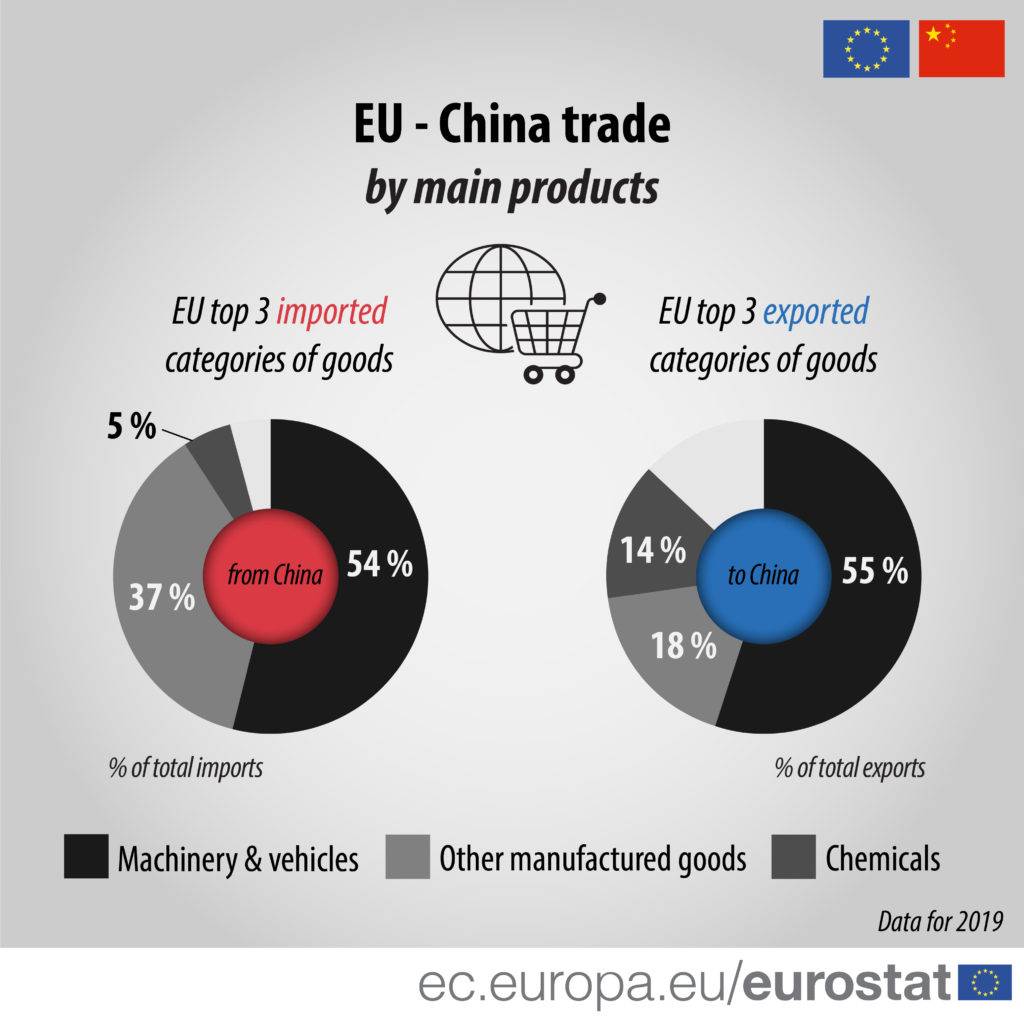
China and the EU are ranked as the world’s two largest exporters but sit third and fifth on the table for global imports and tomorrow’s Silk Road can add great value to what already is an intense economic intercourse between China and the EU. It is all about a similar determination as motivated the ancient traders. According to data, China (16 %) was the largest exporter in the world, followed by the EU-27 (15 %) while PRC was the third largest importer in the world.
Concerning China – EU trade, in 2019 Beijing was the third largest partner for EU exports of goods (9% of total extra-EU exports) and largest for EU imports of goods (19% of total extra-EU imports). During the period 2009 to 2019, the EU had a trade in goods deficit (meaning larger imports than exports) with China, which varied between €104 billion and €164 billion. In 2019 the trade deficit stood at €164 billion. For both EU exports and imports of goods with the China, ‘machinery and vehicles’, ‘chemicals’ and ‘other manufactured goods’ dominate. Together these manufactured goods accounted for 87% of EU exports of goods to China and 97% of EU imports of goods from China. Among the Member States, the Netherlands was the largest importer of goods (€88 billion) from China and Germany was the largest exporter of goods (€96 billion) to China in 2019.

More detail about the goods exchanged between the EU and China is given in figure below, showing the 20 most traded goods at SITC-3 level. These top 20 goods covered 55 % of total trade in goods in 2019. Twelve belonged to machinery and vehicles, seven to other manufactured products and one to chemicals. The most traded product group at this level was telecommunications equipment. Another interesting way to look at the data is to investigate the cover ratio (exports / imports) of traded goods, showing the direction of the trade flows between the two economies. These ratios can be found in the right-hand margin of figure below. Eleven products were below 50 %, indicating EU imports from China were at least twice as large as EU exports to China. Five products were above 200 %, indicating EU exports to China were at least twice as large as EU imports from China. Four products were between 50 % and 200 %, showing more balanced trade.

The pandemic outbreak did not stop China – EU economic dialogue. Following New Silk Road Initiative, in April, rail freight traffic between Europe and China has resumed by more than 90%. By the end of February, 1132 trains had run between China and Europe from the start of the year. This is a 6%. The heavy box rate remained at a high level, and the return journey was basically balanced. This was reported by the national development and Reform Commission (NDRC) and the Chinese government intends to introduce measures to promote the safe, stable and efficient operation of China-EU trains. The Chinese government wants to merge business of China and Europe more efficiently and further simplify the transportation and customs formalities. It also want to innovate the operation modes of goods inspection and loading change, and support the expansion of import and export through the use of China-EU trains.
How much China – EU trade is becoming important for both regional economies? And how much does the EU rely on China? The EU and China enjoy one of the world’s biggest and most dynamic trading relationships. Their trade and investment exchanges have become a major engine driving their respective economic development and innovation. That’s why in “EU-China 2020 Strategic Agenda for Cooperation”, European Union underlined the importance of the annual High-Level Economic and Trade Dialogue as an essential forum for planning and guiding the development of EU-China economic and trade relations as well as taking strategic decisions on important trade, investment and economic issues.

| Cookie | Duration | Description |
|---|---|---|
| cookielawinfo-checkbox-analytics | 11 months | This cookie is set by GDPR Cookie Consent plugin. The cookie is used to store the user consent for the cookies in the category "Analytics". |
| cookielawinfo-checkbox-functional | 11 months | The cookie is set by GDPR cookie consent to record the user consent for the cookies in the category "Functional". |
| cookielawinfo-checkbox-necessary | 11 months | This cookie is set by GDPR Cookie Consent plugin. The cookies is used to store the user consent for the cookies in the category "Necessary". |
| cookielawinfo-checkbox-others | 11 months | This cookie is set by GDPR Cookie Consent plugin. The cookie is used to store the user consent for the cookies in the category "Other. |
| cookielawinfo-checkbox-performance | 11 months | This cookie is set by GDPR Cookie Consent plugin. The cookie is used to store the user consent for the cookies in the category "Performance". |
| viewed_cookie_policy | 11 months | The cookie is set by the GDPR Cookie Consent plugin and is used to store whether or not user has consented to the use of cookies. It does not store any personal data. |